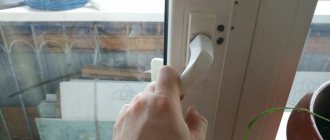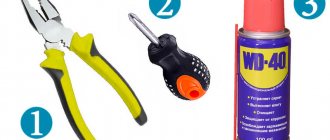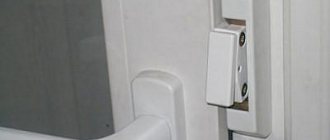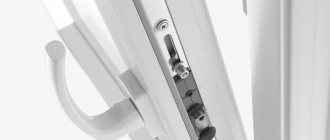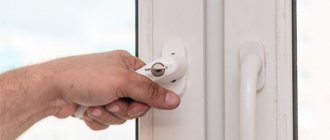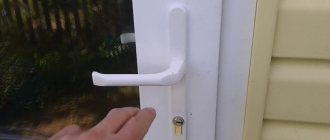In this case, it is important not to aggravate the situation; the problem must be solved consistently.
What problems there may be and how to fix them will be discussed in the article.
Can it jam?
Most often, a situation occurs when, when opening/closing the ventilation mode, the handle “wedges” without turning completely. There are also situations, although much less frequently, when in ventilation mode the handle does not move to the desired position.
If such a problem occurs, it is not recommended to make sudden manipulations with the PVC window; you should not apply force - this can lead to final breakdown of the structure.
This malfunction occurs when the “scissors” - one of the elements of the fittings - jumps out of the grooves. If the window handle is jammed, it is not recommended to make sudden movements. First of all, you just need to close the window.
Why does this happen - reasons
This malfunction may indicate either problems with the sash or a failed frame.
This can be determined without any problems if you open the window completely and lower the handle to the “down” position:
- if the handle rotates and moves without difficulty, then you need to look for a fault in the frame;
- if the handle still does not move or turns with difficulty, then there is a problem with the fittings that are located on the sash.
There are several reasons why the window does not open:
- Incorrect assembly of fittings. As a rule, in this case, the handle jams from the first days and the window does not close from the ventilation mode. If the window is installed by experienced workers, they will immediately notice the problem and fix it.
- Loose fit. The cause of the malfunction in this case is wear of the insulation or a failure in the adjustment of the trunnions.
- Skew. When the mechanism for adjusting the position in the horizontal/vertical plane becomes loose, the sash begins to cling to the edges of the frame and does not fit tightly.
- Switching the leaf into two modes simultaneously. When the window is set to ventilate and open at the same time, the handle is blocked and cannot be turned.
- Foreign objects in fittings. If during operation the sash gradually begins to jam, it is necessary to check the fittings for the presence of foreign objects: dust, dirt, insects, and so on.
- "Wedge" handles. The problem occurs when the scissors pop out of the groove.
- Sagging. Occurs due to changes in window geometry due to wall shrinkage.
- Detached drainage strip. In some situations, the frame may move away from the profile, for example, when dirt gets into the drainage channel, which can cause the window to jam when transitioning from one mode to another.
Once the source of the fault has been found, you can begin the main repair of the PVC window.
The window is stuck and won't open
In most cases, the reason is the blocker mentioned above, or rather, its untimely operation.
If you inadvertently turn the handle down in the open swing position and then close it, the lock may operate.
The further sequence of actions depends on the model of the mechanism. First you need to try to re-close and open the sash alternately in tilt and turn modes.
If the handle does not rotate fully to any of the open positions, try the following:
- With one hand, lightly pull the top corner near the hinges;
- At the same time, try to rotate the handle to the swing position;
- Place the trunnion clamping eccentric vertically.
There are situations when the handle is not jammed, but, on the contrary, rotates around its axis, but the sash does not react in any way to the rotation. This indicates a breakdown of the fittings and in this case it is unlikely that you will be able to do anything on your own. The good news is that such breakdowns do not occur suddenly, but it all starts with play in the handle, which increases over time. Therefore, if you take timely measures and replace the faulty part, you can avoid unpleasant surprises.
Is it possible to fix the problem?
If problems with the window began a long time after the start of operation, in most cases the problem can be solved independently if you have at least basic skills in working with a screwdriver and a hexagon. But there are situations when you cannot do without the help of specialists and high-quality repairs.
It is recommended to call specialists if:
- the seal needs to be replaced;
- the handle is stuck in the “down” position;
- mechanical damage appeared;
- the window opening was warped;
- gearbox is faulty. A gearbox failure can be identified by the presence of a metallic crackling or squeaking sound.
There is no need to try to repair serious damage, this may aggravate the problem.
When to call professionals for help
It is not recommended to repair serious damage yourself. The problem can be made worse rather than solved without proper qualifications. When to call employees:
- replacing the seal. It is recommended that this procedure be carried out only by a person who has a good understanding of window construction in order to avoid damage to the frame;
- mechanical damage and replacement of parts. You should not rely on your own strength when it comes to changing working mechanisms;
- glass falling out of the frame. This situation is life-threatening. It is necessary to immediately call the experts;
- the appearance of mold inside the glass unit. Removal of condensation or fungus must be carried out with special chemicals.
Tools for work
To independently repair a jammed plastic double-glazed window, you do not need any special tools.
Depending on the malfunction, they may be useful:
- Screwdriver Set;
- pliers;
- hammer;
- hexagon;
- screwdriver;
- oil for lubricating parts (synthetic, technical or mineral).
It is also recommended to stock up on a clean rag in advance to wipe your hands and mechanisms.
Summarizing
No one is immune from a window getting blocked/jammed. But you can reduce the likelihood of this trouble occurring. You just shouldn’t neglect regular preventive measures. They are simple; you will need to lubricate the fittings on time and take care of the cleanliness of the mechanisms and internal parts of the window.
It won't hurt to follow these precautions:
- do not use excessive force;
- take your time when opening and closing the door;
- do not leave the doors open during strong winds;
- do not subject the windows to impacts, do not hang anything on the frames;
- Clean and lubricate the mechanism regularly.
The rules are simple, but they will help extend the life of windows.
Step-by-step repair instructions for various problems
Repairing a jammed double-glazed window can be done in various ways, depending on the cause of the malfunction.
Incorrect assembly of fittings
In correctly installed fittings, the trunnions should be located in the center of the groove. It happens that deviations from the norm are minor, invisible at first glance. In this case, you need to hold the lock with your finger and try to turn the handle to different positions. The trunnion that will rest against the edge of the groove needs repair.
To install it in the correct position, it is necessary to carry out certain manipulations :
- unscrew the mounting bolts;
- the faulty pin must be installed in the center of the groove, holding it firmly with your hand, and fix it;
- With your free hand, move the latch to the correct position;
- Without releasing the pin, snap the fastener;
- Screw in one mounting bolt and check the operation of the frame. If the problem disappears, screw in the remaining bolts.
After finishing work, it is recommended to lubricate the fittings.
The handle is stuck in the upper position
If the handle is stuck, then this malfunction can be corrected quickly and relatively easily, the main thing is to strictly follow the sequence of actions :
- The sash is removed from the frame: remove the trim from the top hinge, pull the hinge pin down and pull it out using pliers.
- The sash is removed from the hinge at the bottom: it is enough to lift the structure up a little.
- The grooves from which the “scissors” fell out are identified.
- Press the lock on the end of the frame, install the scissors in the required grooves, and turn the handle.
- Check if the problem is solved: press the lock, turn the knob to different modes, it should turn without effort.
If everything is done correctly, the sash needs to be installed in its place, the upper pin is driven in with a hammer.
If the slopes do not interfere, the sash can not be removed from the frame, but the work can be carried out on site. However, you should not do this without having experience in such work.
Simultaneous opening of the leaf in two modes
This is one of the most common reasons for a PVC window jamming when leaving the ventilation mode.
This problem can be easily solved:
- When the handle is in a vertical position, you need to press the sash directly to the frame from above.
- Press the lock located on the sash.
- Move the handle to the “opening” mode.
After these manipulations, the sash should close without problems.
Sash misalignment
In this case, it is necessary to adjust the position of the plane - horizontal or vertical. The procedure takes place in the following sequence :
- Remove the decorative caps from the inside of the structure (window); under them there are screws that are needed for adjustment.
- Using a hexagon, adjust the screw to the desired position: bottom – up/down, top – right/left.
- After carrying out the manipulations, open and close the window frame.
If the window stops wedging, it means the adjustment was made correctly.
Poor frame care
Plastic double-glazed windows require timely maintenance. All components of the structure must be kept clean and lubricated in a timely manner.
If the window is poorly cared for, if the trunnion is dirty, difficulties may arise when switching from ventilation mode. This problem can be solved very simply: just inspect the end part of the sash and remove dirt from all parts of the fittings.
After cleaning, it is recommended to lubricate all moving parts of the fittings with oil.
Crevices
Gaps in plastic windows appear due to wear of the seal. There may be factory defects that will manifest themselves immediately or after several years of operation. It is important to understand why a plastic window does not close completely - in the first case, repairs are possible, but in the second, a complete replacement is needed. To understand this, you need to examine the place where the sash comes into contact with the frame.
Methods for detecting cracks in a window:
- By hand. Near those places where there are cracks, the skin will feel a breeze and cold. The method only works in winter; in warm weather it is ineffective.
- With a sheet of paper. This test determines the tightness of the sash. If the paper comes out easily, the window is not closed tightly.
- With the help of a candle. Where it blows, the candle flame will deviate.
- By humidity. Moisture from the air in the room always condenses around the cracks. In autumn these are small droplets, in winter they are ice.
Possible difficulties and errors
At first glance, it may seem that closing a plastic window from the ventilation mode when the fittings are “jammed” is a simple matter that even a beginner can do.
However, this is not quite true. Even in this case, it is advisable to have at least basic skills in handling a plastic window.
Often, inexperienced owners make a number of mistakes that lead to the final breakdown of the window system. The most common of them is incorrect identification of the malfunction . For example, the “scissors” have fallen out, and they are trying to repair the trunnions, or they are adjusting the misalignment of the sash instead of simply cleaning the fittings.
Another common mistake is trying to forcefully turn a jammed handle into the desired position. This will inevitably lead to long, expensive window repairs, which only professionals can carry out.
The handle does not turn all the way
First you need to identify the cause of the malfunction. This could be a deformation of the profile, displacement of the strikers, or breakage of the fittings. It is unlikely that you will be able to cope with the deformation on your own, but eliminating the displacement of the slats is quite a feasible task.
- Open the window and try turning the handle.
- If it moves normally to all positions, then in the closed state the clamps rest against the striker bars and thereby prevent the handle from turning completely.
- To find which clamp is not working correctly, unscrew each one one by one. Unscrew one and try to close the window; if that doesn’t work, put it back in place and move on to the next one.
- When the clamp is identified, adjust its position (raise it higher or lower by releasing the fastener).
If the handle does not turn in any position of the sash, the reason is most likely in the fitting mechanism. To find which part of it, do the following:
- Rotate the handle as far as it goes and look at the position of the trunnions. Since the closure is not complete, the trunnions should also not reach the stop. If one of them nevertheless becomes in the closed position, then this is the problem area, namely the incorrect pairing of the fittings.
- We turn the handle to the “open” position and dismantle the problem area.
- We remove the connecting elements and move the trunnion to the same position as the trunnions that did not close completely.
- We assemble in reverse order.
There may be several problem areas; if this is the case, then we identify each one and eliminate the defect using the method described above.

